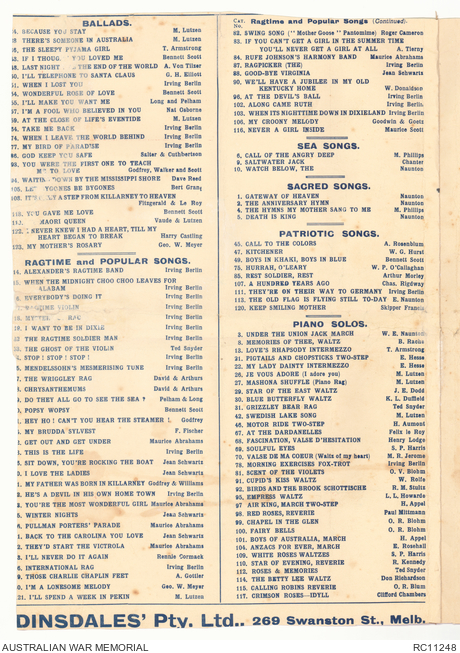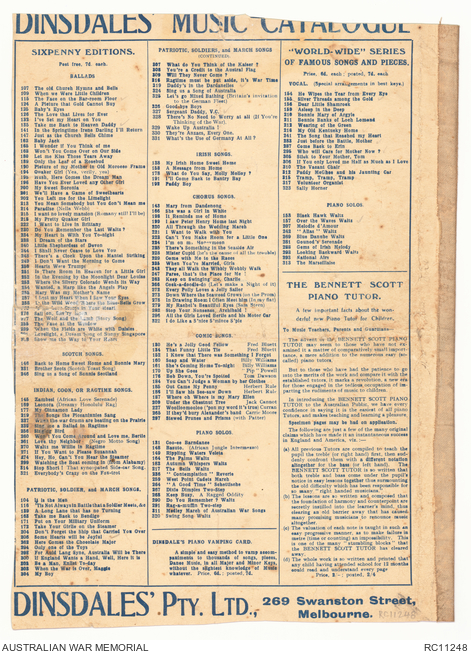| Accession Number | RC11248 |
|---|---|
| Collection number | Sheet Music Collection 763 |
| Collection type | Published Collection |
| Record type | Item |
| Item count | 1 |
| Measurement | Overall: 33 cm x 24 cm |
| Object type | Sheet Music |
| Maker |
Ridgway, Charles |
| Place made | Australia: Victoria, Melbourne |
| Date made | c 1916 |
| Conflict |
First World War, 1914-1918 |
| Copying Provisions | Copyright restrictions apply. Only personal, non-commercial, research and study use permitted. Permission of copyright holder required for any commercial use and/or reproduction. |
[Sheet music] Sing Us a Song of Australia






Sheet music for the song titled, 'Sing Us a Song of Australia', with music and lyrics composed by Charles Ridgway. This copy of the sheet music was published about 1916. The front cover features a photograph of American comedienne Violet Trevenyon, who popularised the song on the Tivoli entertainment circuit. Page 2 features a list of sheet music available from Melbourne-based publishers Dinsdales’ Pty. Ltd., revealing the range of musical styles of the period encompassing ballads, ragtime, popular songs, sea songs, sacred songs, patriotic songs and piano solos. On page 3, the name of Chas. Vaude appears as the lyricist and composer. Charles Vaude was actually the stage name of Charles Ridgway, a popular comedian of the period. The back cover features another list of items available from Dinsdales’ Pty. Ltd. such as sixpenny editions of ballads as well as patriotic, soldier and march songs. The retail price for this copy was 6d (six pence).
‘Sing Us a Song of Australia’ narrates the story of Australian soldiers in three different situations (camping at base, returning to the trenches and in hospital), demanding to hear a song about Australia that would remind them of home. The song was written by Charles Ridgway during the First World War after hearing a story about a benefit concert for wounded Australian soldiers in London. As explained on the front cover, the author was inspired to write the song in response to ‘The Australians, who had no songs of their own on the programme, at the finish of Ada Crossley’s item, called ‘Coo-ee, Coo-ee,’ to each other across the Auditorium.’
The concert in question appears to be one held at His Majesty’s Theatre in London on 19 November 1915, which was widely reported in the Australian newspapers several days later, albeit with a slightly different narrative. As reported by The Argus, ‘Miss Alice Crawford deeply stirred the audience by her recitation of Bracken’s ‘Old Bendigo’, the Australians rising and cheering the mention of familiar home names.’ As an encore, she gave the “Coo-ee”, and ‘A hush fell on the audience during the rendering of the verse describing the heroism of the fallen Australians at Gallipoli, while at the close a most remarkable scene took place, during which the refrain “Coo-ee” echoed and echoed in all parts of the house.’
Towards the bottom of this page is a sound recording of this sheet music, or a parody, that was created as part of the Music and the First World War project. More information about this recording, including names of the performers, can be found on the catalogue record for the sound recording. A link to the catalogue record for the sound recording can be found at the bottom of this page, under the heading ‘Related objects’ where it can be identified with the prefix [sound recording].
- Download PDF document of [Sheet music] Sing Us a Song of Australia (file)
-
Listen to
[Sheet music] Sing Us a Song of Australia